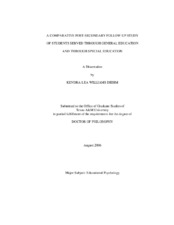| dc.description.abstract | This study examines the preparation during high school and post-secondary outcomes of students with disabilities. High school preparation consists of activities in which students participated during high school. Post-secondary outcomes relate to the current status of students following high school graduation in relation to the four major outcomes areas: (a) post-secondary education, (b) employment, (c) independent living, and (d) recreation and leisure. The target population included all students graduating from one school district in a mid-sized city in Texas. A stratified random sample of 228 students both with and without disabilities was selected. Post-secondary follow-up surveys, consisting of one survey administered prior to graduation and one survey administered six-months following graduation, were given to the participants. The response rate for the initial exit survey was 82.9% while the response rate for a post-school survey was 61.4%. Differences between groups were analyzed using loglinear analyses based upon educational setting, disability category, gender, ethnicity, and socio-economic status. In addition, a sub-study was completed to determine the level of agreement among students and teachers on a post-secondary readiness skill inventory. The findings indicated that differences among groups did exist in terms of both high school preparation and post-secondary outcomes. In terms of high school preparation, the participation among various groups produced few results that were significantly different. Statistically significant results occurred only with respect to extracurricular activity participation by educational setting and socio-economic status. Post-secondary outcome results produced more statistically significant findings than high school preparation. The variable of educational setting produced statistically significant post-secondary outcomes in the three areas of employment, post-secondary education, and recreation and leisure. Ethnicity was the next largest determinant to influence post-secondary outcomes, and statistically significant results were found for both post-secondary education and independent living. Socio-economic status produced statistically significant results for employment outcomes. The variable of gender produced no results that reached statistical significance. The last findings provided an analysis of the agreement between students and teachers in terms of a post-secondary readiness skill inventory. Overall students and teachers demonstrated a high level of congruency in which similar responses were indicated within 95% of the items. | en |


